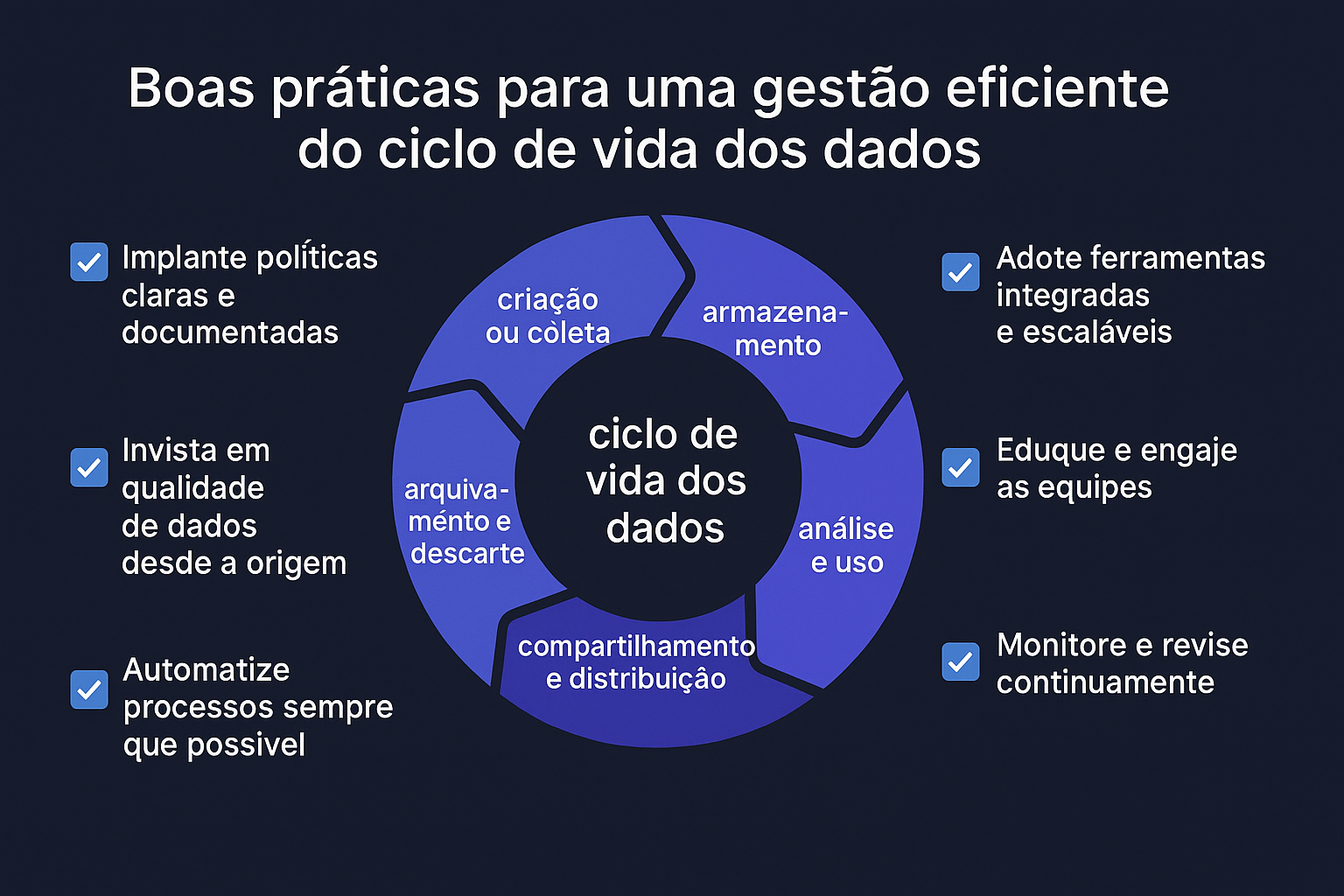We live in a data-driven era. Companies across all sectors accumulate massive volumes of information every day — but they don’t always know how to make the most of it. Understanding the data lifecycle is essential to transform this raw asset into strategic knowledge and generate real business value.
The data lifecycle describes every stage a piece of data goes through: from the moment it is created or collected, through storage, processing, analysis, and use, all the way to archiving and secure disposal. Managing this cycle properly not only improves decision-making quality but also ensures compliance with regulations like the LGPD and reduces operational and financial risks.
In this article, we’ll explore each phase of the data lifecycle, share best practices for efficient management, and show how data governance is essential for companies that aim to become truly data-driven. Whether you’re a technical professional, a manager, or a student, you’ll find valuable insights here to elevate your organization’s data culture to the next level.
Step 1: Data Creation or Collection
The first step in the data lifecycle is precisely the moment data comes into existence: creation or collection. This stage defines the quality of the foundation that will support the entire process — after all, there’s no good analysis without good data.
Data sources can be internal (such as ERP systems, CRM platforms, financial operations, IoT sensors) or external (market research, social media, suppliers, public databases). Additionally, data can be structured (numbers, tables, records) or unstructured (images, videos, free text), requiring different approaches when capturing and storing them.
Some best practices for data collection include:
- Ensuring user consent, especially in contexts regulated by laws such as LGPD or GDPR;
- Avoiding excessive or unnecessary data collection (gather only what will actually be used);
- Validating and standardizing data at the source whenever possible, to reduce future rework;
- Integrating different sources in a planned way, avoiding duplication or inconsistencies.
Step 2: Data Storage
After being collected, data must be stored securely, in an organized and accessible manner — after all, storage is where data waits to be processed and analyzed. This phase of the data lifecycle is crucial to ensure integrity, availability, and efficiency.
There are different forms of storage, including:
- Relational databases (SQL): Ideal for structured data and fast queries;
- NoSQL databases: Suitable for unstructured data and large volumes of heterogeneous information;
- Data warehouses and data lakes: Used to centralize and organize data from multiple sources;
- Cloud storage: offers scalability, flexibility, and lower infrastructure costs;
- On-premisestorage: With dedicated servers, used by companies with specific security or regulatory requirements.
Some critical points at this stage include:
- Security: Implement encryption, access controls, and backup policies;
- Performance: Ensure storage does not create bottlenecks for future usage;
- Compliance: Follow regulations like LGPD and GDPR regarding where and how data can be stored;
- Cost-effectiveness: Balance between active storage (frequently used data) and archiving (rarely accessed data).
In short, it’s not enough to simply “store data” — it must be organized, protected, and ready to be used intelligently.
Step 3: Data Processing
With data properly stored, it's time to prepare it for use — and this is where data processing comes in, a key stage in the data lifecycle. This process transforms raw information into material ready for analysis, ensuring that errors, noise, and inconsistencies don’t compromise the results.
Data processing typically includes:
- Data cleaning: Removing duplicates, correcting typos, handling missing values;
- Standardization: Adjusting formats (such as dates, currencies, and codes) to ensure consistency across sources;
- Integration: Merging data from different systems and sources to create a unified, consolidated view;
- Transformation: Applying calculations, generating new indicators, and preparing data for analytical models or reports.
The tools used vary depending on complexity — from simple spreadsheets and scripts to advanced ETL (Extract, Transform, Load) platforms, integration tools, and automated pipelines.
Key challenges at this stage include:
- The growing volume of data (big data);
- Diversity of formats and data origins;
- Time required to prepare data without compromising business agility.
Data processing is like a careful triage: only once data is clean, organized, and structured can it truly deliver value to the business.
The first three stages (from collection to processing) fall under what we call Data engineering. Neglecting this part of the work can cause a domino effect: dirty data, inaccurate analyses, and poor decisions. That’s why investing in well-defined processes and the right tools is essential for a healthy data lifecycle.
Step 4: Data Analysis and Use
After being collected, stored, and processed, data is ready to fulfill its most valuable role in the data lifecycle: generating insights and guiding decision-making.
Data analysis transforms numbers and records into relevant information that helps companies understand the past, monitor the present, and predict the future. This stage includes several analytical approaches, such as:
- Descriptive analysis (What happened?);
- Diagnostic analysis (Why did it happen?);
- Predictive analysis (What is likely to happen?);
- Prescriptive analysis (What should we do?).
Tools and technologies commonly used in this stage include Business Intelligence (BI) platforms like Power BI and Tableau; Machine Learning and Artificial Intelligence models for predictions and classifications; and interactive dashboards and custom reports.
Key benefits for organizations include:
✅ Stronger foundation for strategic decision-making;
✅ Identification of opportunities and risks;
✅ Process optimization and improved efficiency;
✅ Personalization of products and services for customers.
However, it’s important to note: analysis is only powerful when based on high-quality data and interpreted correctly. This is where the human factor (skilled teams) and a data-driven culture make all the difference.
Step 5: Data Sharing and Distribution
After being analyzed, data and insights need to be shared with the right people — and this stage of the data lifecycle is just as strategic as the ones before it.
Sharing data isn’t just about sending reports by email. It’s about ensuring that relevant information is accessible, at the right time, to the right people who need it to take action. This includes executives, managers, operational teams, partners, and in some cases, even customers.
Key considerations at this stage include:
- Access control: Not everyone should have access to all data. It’s essential to define who can view what, respecting security and privacy principles.
- Proper formats: Data can be distributed through interactive dashboards, automated reports, APIs integrated with external systems, executive presentations, among others.
- Frequency and updates: Outdated information can lead to poor decisions. That’s why it’s important to establish clear update and distribution cycles.
- Education and interpretation: It’s not enough to make data available — people need to understand what it means and how to use it in practice.
Beyond enhancing decision-making, this stage also strengthens a data-driven culture, where data is no longer a resource restricted to the IT department but becomes part of the organization’s daily operations.
Step 6: Data Archiving and Retention
Not all data needs to be available for constant use — and that’s where the archiving and retention stage of the data lifecycle comes in. This phase ensures that information is kept for the necessary amount of time, meeting legal, operational, and strategic requirements, without occupying unnecessary space or consuming active system resources.
Key aspects of this stage include:
- Retention policies: Define how long each type of data should be kept. For example, tax records may have legally defined periods, while operational logs can be discarded after just a few months.
- Smart archiving: Less frequently accessed data can be moved to lower-cost storage solutions (such as cold cloud storage), freeing up resources in the main environment.
- Compliance and auditing: Proper retention helps organizations comply with regulatory requirements (such as LGPD, GDPR, tax and accounting standards) and stay prepared for audits.
- Organization and traceability: Even when archived, data must be organized in a way that allows it to be quickly located when needed.
Efficient management of this phase reduces operational costs, minimizes risks, and maintains the right balance between availability and security.
Step 7: Secure Data Disposal and Deletion
The data lifecycle doesn’t end with archiving — it only truly closes with the secure disposal and deletion of information. This is a critical stage, often overlooked, but essential to protect the organization from legal, financial, and reputational risks.
Why securely delete data?
- To comply with regulations (such as LGPD and GDPR), which establish the right to be forgotten and limit data retention periods;
- To prevent leaks of sensitive information;
- To reduce storage costs associated with obsolete or unnecessary data;
- To keep the data environment clean, organized, and efficient.
Best practices for secure data disposal include:
✅ Using data wiping tools that make deleted data unrecoverable;
✅ Physically destroying media when necessary (such as old hard drives);
✅ Logging and auditing the disposal process to ensure traceability and compliance;
✅ Clearly defining responsibilities: who authorizes, who executes, and who verifies the deletion.
Disposal doesn’t just mean “deleting” — it means responsibly closing the lifecycle of that data, ensuring it no longer poses any future risk.
Benefits of Properly Managing the Data Lifecycle
Managing the data lifecycle effectively is not just a technical matter — it’s a strategic competitive advantage. Companies that take care of their data from beginning to end reap significant benefits across multiple areas.
Key benefits:
✅ Higher information quality: Well-collected, processed, and updated data leads to more accurate and reliable analysis.
✅ Improved decision-making: With high-quality information, leaders and teams have more confidence to make quick decisions aligned with business goals.
✅ Cost reduction: A well-managed lifecycle avoids unnecessary storage, rework, resource waste, and legal-related costs.
✅ Regulatory compliance: Care throughout all stages — especially retention and disposal — ensures alignment with regulations like LGPD and GDPR, avoiding fines and penalties.
✅ Increased operational efficiency: Automated processes and organized data streamline team workflows, freeing up time for strategic activities.
✅ Strengthened internal and external trust: Clients, partners, and employees have more confidence in companies that demonstrate responsibility in the use and protection of data.
In today’s environment, where data is a valuable asset, managing it well is not optional — it’s essential for those who want to compete and grow intelligently.
The Role of Data Governance in the Data Lifecycle
Data governance is the foundation that supports the entire data lifecycle. Without it, even the best tools or processes can fail, leading to inconsistencies, risks, and loss of value.
What is data governance?
It’s the set of policies, processes, responsibilities, and tools that ensure an organization’s data is managed securely, ethically, efficiently, and in alignment with business goals.
How governance impacts each stage of the lifecycle:
- In collection: Defines which data should be collected, how, and for what purpose.
- In storage: Establishes rules for security, classification, and access control.
- In processing: Ensures data quality, standardization, and traceability of transformations.
- In analysis: Guides the ethical and responsible use of information, avoiding bias or misinterpretation.
- In sharing: Defines access, privacy, and consent policies.
- In archiving and disposal: Determines retention periods, responsibilities, and secure methods for keeping or eliminating data.
Data governance is the connecting thread that aligns every stage of the lifecycle, ensuring data fulfills its strategic role with security and reliability.
Common Challenges in the Data Lifecycle
Despite its many benefits, managing the data lifecycle is not simple — and companies of all sizes face recurring challenges throughout its stages. Identifying these weak points is the first step toward overcoming them.
Main challenges:
⚠️ Improper data collection: Data collected without standardization, with duplicates, missing information, or without consent creates problems that compound over time.
⚠️ High costs: Maintaining redundant data, disorganized storage, and a lack of automation can lead to unnecessary expenses with infrastructure, licensing, and labor.
⚠️ Low performance: Disorganized data, inadequate infrastructure, and unoptimized processing can lead to slow access and analysis, affecting decision-making agility.
⚠️ Disorganized storage: The lack of classification, version control, or structure makes it difficult to access data and prevents business teams from efficiently using it for strategic analysis.
⚠️ Compromised processing quality: Without clear processes for cleaning and integration, data carries errors that negatively impact analysis and decisions.
⚠️ Lack of cross-functional integration: When data remains locked in departmental silos, companies lose global visibility and strategic opportunities.
⚠️ Weak security: Vulnerabilities in data storage, processing, or sharing can expose sensitive information to leaks or cyberattacks.
⚠️ Improper data disposal: Failing to properly eliminate data poses legal and reputational risks, especially in regulatory contexts such as LGPD and GDPR.
These challenges highlight the importance of not viewing the data lifecycle as a series of isolated steps, but as an integrated flow that requires continuous planning, coordination, and monitoring.
Best Practices for Efficient Data Lifecycle Management
Efficiently managing the data lifecycle isn’t just about technology — it also requires strategy, organizational culture, and discipline. Best practices are essential to ensure each stage works in alignment and delivers real business value:
Establish clear and documented policies
Define guidelines for data collection, storage, usage, retention, and disposal. Document roles and responsibilities to ensure everyone in the organization knows what to do (and what to avoid).
Invest in data quality from the source
Standardize data entries, validate information at the point of input, and eliminate unnecessary data. This reduces rework during processing and increases the reliability of analysis.
Automate processes whenever possible
Use ETL tools, automated integrations, and approval workflows to boost efficiency, reduce human error, and free up teams to focus on strategic activities.
Educate and engage your teams
Provide training on the importance of a data-driven culture and best practices for data usage and security. Well-informed people are the first line of defense against errors and data breaches.
Continuously monitor and review
Implement performance indicators (KPIs) for the data lifecycle, such as data quality, usage rates, processing time, and compliance. Periodically review processes to adapt to changes in business needs or regulations.
Adopt integrated and scalable tools
Look for solutions that integrate well with each other and can scale as your company grows — avoiding the creation of new silos or bottlenecks.
These practices help turn data management into a competitive advantage, raising the organization's level of digital maturity.




